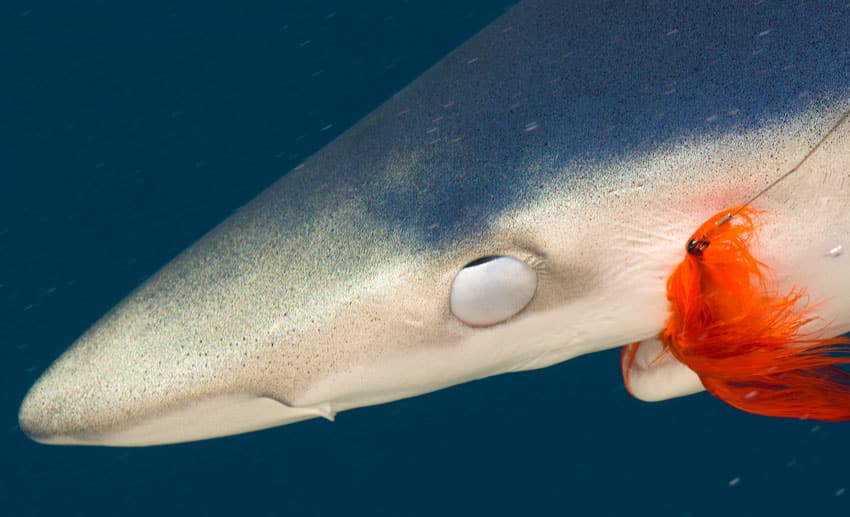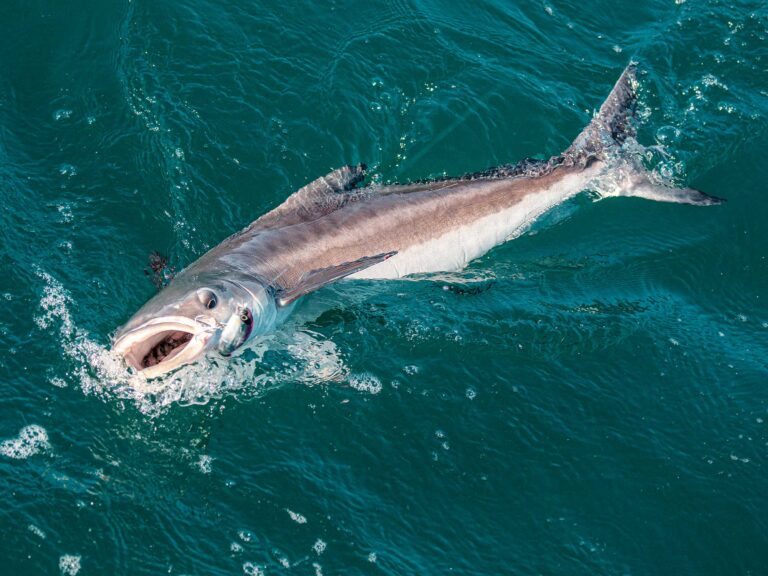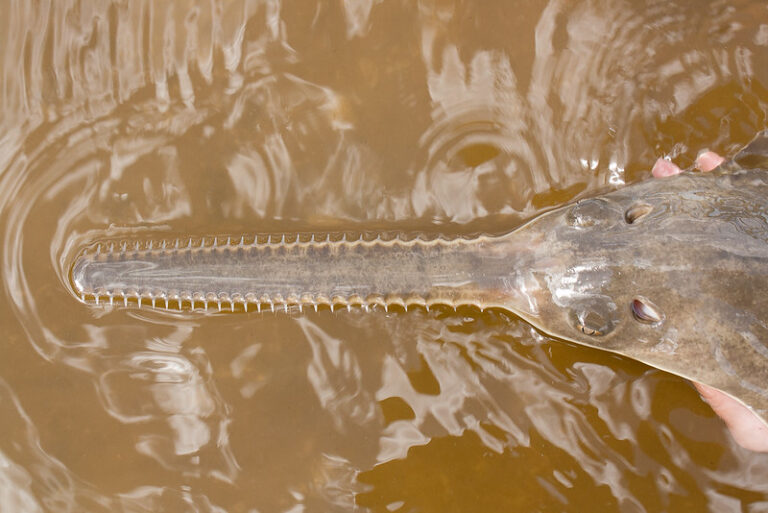
Winter is typically when anglers clean up their gear, catch up on the newest techniques and technology, and start planning for the next big trip. During winter, the closest I come to any offshore game fish is when I reach past them in my freezer to get more ice for my next cocktail.
So when Capt. John Hendrickson of San Diego Fly Shop asked me if I’d be interested in going offshore to catch some big fish on fly, I jumped at the chance. Hendrickson admitted that, this time of year, most of the fish that come up in the slick are blue sharks, not the makos known for their power and stunning aerial maneuvers. But I had never caught any kind of shark on fly, so I said, “What the heck? What else is there to do in the middle of January?”
It was a beautiful morning in San Diego. A northerly breeze etched the cool blue waters along the crescent-shaped coastline. Pods of dolphin shimmered intermittently upon the endless watery plane; the all-too-comfortable and clever seals performed their morning vocal exercises; and whales spouted in the distance.
Sharky Water
Finding sharks is not much different than searching for other big game fish. Using topographical maps of the sea bottom is a good place to start. Underwater structures, such as canyon ridges with steep drops and high points, cause current breaks and upwellings. These conditions hold baitfish and, in turn, attract other larger species, and areas with these features offer promising places to drift in search of fish.
Hendrickson explained that you want to aim your drift at a particular point to intersect suspected hot spots. Birds and baitballs are usually signs that you are in the right area. Determine which direction you will be moving once the motor is killed, based on wind and current conditions. The size of your boat and the strength of the wind and current will dictate the speed. “Bigger boats have more sail than smaller boats, so they move faster, which will allow you to cover more ground,” said Hendrickson. “The more ground you cover, the better you are going to do.” Using a chart plotter, or even a simple GPS tracking device, is a good way to monitor the progress of your drift.
Hendrickson decided that the top of the Nine Mile Bank would be a good place to start our drift. We were expecting the wind to shift to a more easterly direction by 11, and we hoped that Mother Nature would cooperate and graciously nudge the 25-foot Parker along our intended path, so we set the chum over the side and waited while the current spread a broad slick in front of us. We soaked chum for about 35 minutes, then it happened.
“Game on,” said Hendrickson quietly from his perch on the transom, where he stood watching. I turned and looked out over the slick at an endless expanse of silver-speckled blue water divided by an oily highway trailing off into the distance. Then I got a glimpse of what Hendrickson had seen: Carving up the chum line like a windsurfer on a blustery day came the dorsal fin of a curious blue shark, a 6-footer.
The Big Tease
Sharks have personalities, and each one approaches differently. “Sometimes they’ll come in fast, looking for any food that falls in the water so that they can get a meal,” said Hendrickson. “You know they are ready to eat. Other times, they’ll come in super slow, checking things out.” That is what the teaser is for, he explained. He picked up a bait-casting rod rigged with a hookless dead mackerel and sailed it toward the shark. The scent of the mackerel and the flash in the morning sunlight soon had this blue licking its chops.
Sitting comfortably at the top of the food chain, sharks rarely spook, giving you ample time to prepare for the encounter. Upon first seeing the fish, you can take your time, size it up and choose your weapon. I picked up a 12-weight and made my way to the bow.
When you are ready to execute the bait-and-switch, it is best to cast the teaser so the shark attacks it at a 45-degree angle, moving away from the boat. That angle makes it easy to set the hook firmly in the corner of the shark’s mouth instead of risking yanking it away in an attempt to set it.
Hendrickson tossed the teaser about 30 feet from the boat and instructed me to cast as close to it as I could as soon as the shark locked in on it. The shark beelined toward the teaser, and I dropped the fly alongside it. Hendrickson pulled it from the water, and bam! Smackola. The shark surfaced and chowed down the fly. It’s just that simple.
A couple of firm strip strikes set the hook, and the shark started thrashing the surface into a very uninviting whirlpool. Then it was gone, peeling off 200 feet of line in seconds. I held on, hoping the shark wouldn’t roll on the line. Then after a few minutes, I felt it slowing, so I start pulling.
Fair Fight
When you’re pulling on big fish, especially with a fly rod, it is important to fight the fish with the butt of the rod, where you can generate maximum power and torque. Use short, powerful strokes and avoid raising the rod above eye level in order to maximize your efforts.
When my catch finally came alongside the boat, we kept it in the water, turned so the hook was on the inside and accessible. With a long-handled dehooker, which minimizes the chance of injury to the gaffer, angler and fish, we easily popped the barbless fly out of the shark’s jaw, then we watched the fish swim back where it belonged.
San Diego Sharks
San Diego is home to not only blues and makos; thresher sharks and great whites also have been caught in coastal waters on flies. It is not uncommon to see two or more different shark species on a single outing.
What: Fly-fishing for blue sharks.
When: October through April.
Where: San Diego, California.
Who: When you’re fishing for these creatures, it is important to put safety first. Blues rarely leave the water but can be dangerous when aggravated. If you want to face off with any shark, be sure to have the right gear and know how to use it. Take your maiden voyage with an experienced captain and you’ll gain knowledge and an additional margin of safety.
Capt. John Hendrickson
858-350-3111
www.sandiegoflyshop.com
Bowman Bluewater
619-822-6256
www.bowmanbluewater.com
When selecting your rig, don’t be afraid to scale up. Have three or four rods from 10- to 18-weight set up, to maximize your chance of landing a fish and minimize arm pumping. While not IGFA-legal, the practice of shark fishing that Hendrickson inherited from Capt. Conway Bowman and Capt. Dave Trimble, was designed to offer as much fun as possible while causing the least amount of damage to the sharks. Tactics include matching rod strength to shark size and fishing with barbless hooks.
Rods: 812- or 9-foot 10- to 18-weight fly rods, like Sage Xi3, Rajeff Sports Echo 2 Saltwater or equivalent.
Reels: Large-arbor reels able to hold 200 yards of backing, such as those by Abel, Galvan or Tibor.
Lines: Weight-forward floating fly line, such as 550-grain RIO Leviathan Big Game floating or similar line for 12- to 16-weight rods; it may help to go one line weight heavier than the rod rating to help turn over the leader with a bulky fly.
_
Leaders:_ 3 feet of 40-pound monofilament attached to a welded, forged welded or forged ring (aka a tuna ring) ending in 2 feet of 86-pound single-strand wire tippet Haywire Twisted to the hook.
Flies: 10- to 12-inch tube flies in red or orange, such as Trimble Shark flies by Umpqua, rigged over wide-gap 6/0 to 10/0 J hooks, such as Gamakatsu SL12S, Tiemco 600SP or equivalent.


Choose Your Weapon










